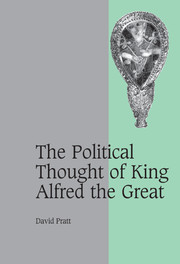Book contents
- Frontmatter
- Contents
- Acknowledgements
- List of abbreviations
- Note on citations
- Chapter 1 INTRODUCTION
- Part I The West Saxon Political Order
- Part II Alfredian Discourse and its Efficacy
- Chapter 7 THE FIELD OF ALFREDIAN KNOWLEDGE
- Chapter 8 THE CONSTRUCTION OF ALFREDIAN DISCOURSE
- Chapter 9 ALFREDIAN TECHNOLOGY: BOOKS AND ÆDIFICIA
- Chapter 10 THE HIERDEBOC AS A TREATISE OF POWER
- Chapter 11 THE DOMBOC AS A REORIENTATION OF ROYAL LAW
- Chapter 12 TRIBULATION AND TRIUMPH IN THE FIRST FIFTY PSALMS
- Chapter 13 THE SEARCH FOR A SATISFACTORY CONSOLATION
- Chapter 14 SEEING GOD AS HE IS
- Chapter 15 CONCLUSION
- Appendix: West Frankish deployment of Solomon's dream
- Bibliography
- Index of manuscripts
- General index
- Cambridge Studies in Medieval Life and Thought Fourth Series
Chapter 9 - ALFREDIAN TECHNOLOGY: BOOKS AND ÆDIFICIA
Published online by Cambridge University Press: 06 July 2009
- Frontmatter
- Contents
- Acknowledgements
- List of abbreviations
- Note on citations
- Chapter 1 INTRODUCTION
- Part I The West Saxon Political Order
- Part II Alfredian Discourse and its Efficacy
- Chapter 7 THE FIELD OF ALFREDIAN KNOWLEDGE
- Chapter 8 THE CONSTRUCTION OF ALFREDIAN DISCOURSE
- Chapter 9 ALFREDIAN TECHNOLOGY: BOOKS AND ÆDIFICIA
- Chapter 10 THE HIERDEBOC AS A TREATISE OF POWER
- Chapter 11 THE DOMBOC AS A REORIENTATION OF ROYAL LAW
- Chapter 12 TRIBULATION AND TRIUMPH IN THE FIRST FIFTY PSALMS
- Chapter 13 THE SEARCH FOR A SATISFACTORY CONSOLATION
- Chapter 14 SEEING GOD AS HE IS
- Chapter 15 CONCLUSION
- Appendix: West Frankish deployment of Solomon's dream
- Bibliography
- Index of manuscripts
- General index
- Cambridge Studies in Medieval Life and Thought Fourth Series
Summary
Alfredian theatre privileged reading, essential to the delivery of vernacular prose. Translation offered the imagined reading of a Latin text; its re-enactment was no less dependent on reading and recitation. Much of the novelty of Alfredian theatre lay in its exploitation of literacy as a form of mental technology, extending beyond direct interaction to include more open-ended priorities of wisdom and self-restraint. Such mental effects were in turn dependent on material innovation, geared to the demands of the royal written word. Book production was inescapable, yet innovation extended further, to artefactual production. Alfredian books were matched by a series of novel objects, also implicated in the literate acquisition of wisdom. As a centre of production as well as performance, the royal household was enhanced by the unity of investigative enterprise. The outcome was a co-ordinated system of technology, oriented towards the king's mental goals. The court itself supplied all necessary mechanisms of projection, enhancing the reins of its central control.
BOOKS AND BOOK PRODUCTION
Textual duplication was essential for wider performance. ‘Re-education’ witnessed the copying of manuscripts on a considerable scale. Multiple copies of the Hierdeboc were required for episcopal recipients; comparable processes lay behind the ‘common stock’ of the Chronicle and the law-book. Dissemination of other royal texts is supported by context, prefatory material and transmission-history. Precise mechanisms are clouded by uneven evidence.
- Type
- Chapter
- Information
- The Political Thought of King Alfred the Great , pp. 179 - 192Publisher: Cambridge University PressPrint publication year: 2007



